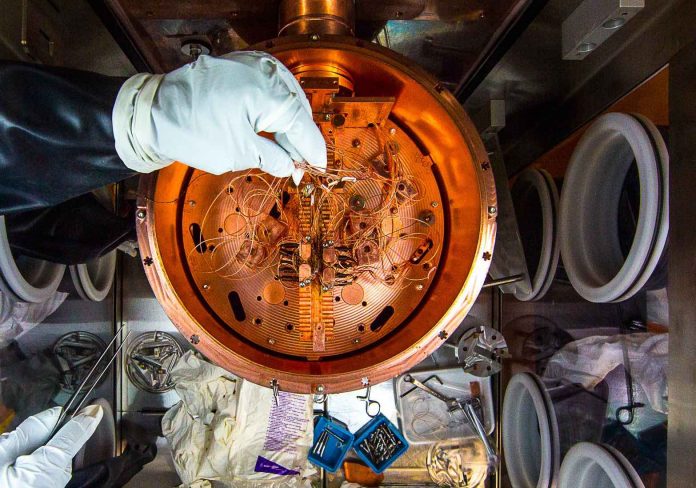If equal amounts of matter and antimatter had formed in the Big Bang more than 13 billion years ago, they would have annihilated one other upon meeting — and today’s universe would be full of energy but no matter to form stars, planets and life.
Yet, matter exists now. That fact suggests something is wrong with the Standard Model of Physics — which as written states that there is symmetry between subatomic particles and their so-called “antiparticles.” In a study published March 26 in Physical Review Letters, collaborators of the MAJORANA DEMONSTRATOR, an experiment led by the Department of Energy’s Oak Ridge National Laboratory and including researchers at the University of Washington, have shown they can shield a sensitive, scalable 44-kilogram germanium detector array from background radioactivity.
This accomplishment, which involves a collaboration among 129 researchers from 27 institutions and 6 nations, is critical to developing a much larger future experiment to study the nature of neutrinos. UW researchers in the collaboration are based in the Center for Experimental Nuclear Physics and Astrophysics and the Department of Physics.
“The excess of matter over antimatter is one of the most compelling mysteries in science,” said John Wilkerson of ORNL and the University of North Carolina, Chapel Hill, who leads the MAJORANA DEMONSTRATOR. “Our experiment seeks to observe a phenomenon called ‘neutrinoless double-beta decay’ in atomic nuclei.”
Observing neutrinoless double-beta decay would show that neutrinos are their own antiparticles, according to Wilkerson. If so, physicists would have to rewrite the Standard Model.
“Observing neutrinoless double-beta decay would be a major step forward in understanding the predominance of matter in the universe,” said Jason Detwiler, a UW professor of physics and co-spokesperson for the MAJORANA Collaboration. “It is one of the most compelling questions in theoretical physics and impacts fundamental questions about where we come from and why we exist.”
Neutrinoless double-beta decay has never been observed, though nearly a dozen experiments have sought it. One of the keys to detecting this long-theorized form of atomic nuclear decay lies in minimizing background effects that could be mistaken for the real phenomenon.
That was the key accomplishment of the MAJORANA DEMONSTRATOR. This experiment was completed in South Dakota in September 2016 at the Sanford Underground Research Facility. Setting the experiment under nearly a mile of rock was the first of many steps collaborators took to reduce interference from background effects. Other steps included a cryostat made of the world’s purest copper and a complex six-layer shield to eliminate interference from cosmic rays, radon, dust, fingerprints and naturally occurring radioactive isotopes.
There are many ways for an atomic nucleus to fall apart. In two-neutrino double-beta decay — a process that has been observed — two neutrons decay simultaneously to produce two protons, two electrons and two antineutrinos. But the MAJORANA Collaboration seeks evidence for a decay process in which no neutrinos are emitted.
Observing neutrinoless double-beta decay would contradict a principle that was written into the Standard Model: The conservation of the number of leptons. Leptons are subatomic particles such as electrons and neutrinos. Many theorists believe that lepton number is actually not conserved, and that the neutrino and the antineutrino are really the same particle spinning in different ways. Italian physicist Ettore Majorana introduced this concept in 1937, predicting the existence of particles that are their own antiparticles.
The MAJORANA DEMONSTRATOR uses germanium crystals as both the source of double-beta decay and the means to detect it. The scientists distinguish between two-neutrino and neutrinoless decay modes by their energy signatures.
“It’s a common misconception that our experiments detect neutrinos,” said Detwiler, who is also a co-author on the paper. “It’s almost comical to say it, but we are searching for the absence of neutrinos. In the neutrinoless decay, the released energy is always a particular value. In the two-neutrino version, the released energy varies but is always smaller than for neutrinoless double-beta decay.”
The MAJORANA DEMONSTRATOR has shown that the neutrinoless double-beta decay half-life of germanium-76 is at least 1025 years — 15 orders of magnitude longer than the age of the universe. That’s a long time to wait.
“We get around the impossibility of watching one nucleus for a long time by instead watching on the order of 1026 nuclei for a shorter amount of time,” said co-spokesperson Vincente Guiseppe of the University of South Carolina.
Chances of spotting a neutrinoless double-beta decay in germanium-76 are no more than 1 for every 100,000 two-neutrino double-beta decays, Guiseppe said. But using detectors containing large amounts of germanium atoms increases the probability of spotting the rare decays.
Between June 2015 and March 2017, the scientists observed no events with the energy profile of neutrinoless decay, an absence that had been expected given the small number of germanium nuclei in the detector. But they were encouraged to see many events with the energy profile of two-neutrino decays, verifying the detector could spot the decay process that has been observed.
The MAJORANA Collaboration’s results coincide with new results from GERDA, a parallel experiment in Italy.
“The MAJORANA DEMONSTRATOR and GERDA together have the lowest background of any neutrinoless double-beta decay experiment,” said ORNL’s David Radford.
The DEMONSTRATOR was designed to demonstrate that backgrounds can be low enough to justify building a larger detector. The MAJORANA DEMONSTRATOR will continue to take data for two or three years. Meanwhile, a potential merger with GERDA is in the works to develop a one-ton detector called LEGEND.
“This merger leverages public investments in the MAJORANA DEMONSTRATOR and GERDA by combining the best technologies of each,” said LEGEND co-spokesperson Steve Elliott of Los Alamos National Laboratory, who was a long-time spokesperson for MAJORANA until 2017.















